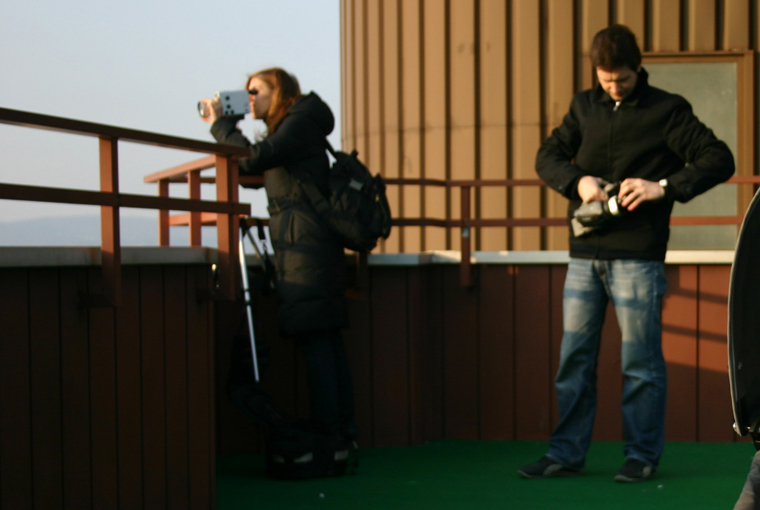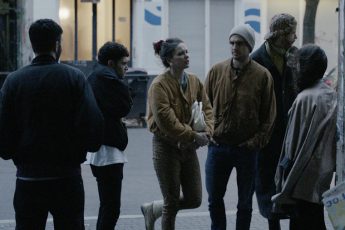
I met Mona Vatamanu and Florin Tudor in their studio in Berlin where they showed me their work, and the following conversation took place.
One of your recent works “The Right of Spring” (2010) is about Romanian children burning fallen rows of white poplar fluff on the streets.
Two years ago, we saw some kids on the street starting small fires with white poplar fluff. The fire was consuming the white fluff instantly. It was like an immaterial action. We witnessed this, mesmerized, and we wanted to come back the next year to try to film it. The gesture of burning the fluff was a metaphor for change. We thought the footage had significance in connection with the banlieu burnings that happened in Paris a couple of years ago. The idea being that one spark ignites a whole mass of fluff, like in a chain reaction. Now this poetic gesture also has political association to what started this spring in North Africa.
So how do you link little kids burning the fluff to a precise political event without showing it?
There is no need to be obvious. Something is entirely consumed by fire and disappears, it’s about reality and life. There is always some kind of violence coming from the fire, and from the idea of fire spreading very quickly. There is also hope- hope for change, hope for a renewed life.
A lot of your other works – for example Procesul (2004-2005) or Vacaresti (2006) deal with architecture. What interests you about architecture?
Architecture says a lot about people, it is like representing people without showing them. Now we are maybe showing people more in our videos, but the focus is the same. In Procesul, a video about the trial of Ceauşescu, we mostly filmed architecture, trying to talk about us Romanians and about collective guilt. In a way, now things look like they have changed. The concrete blocks you can see in Procesul might have been repainted and improved with shopping malls, but the problem inside is still there.
Why did you choose to show images of socialist buildings in association with the Ceauşescu trial?
Mainly because it’s a subjective thing. It’s impossible not to confront these buildings when you live in Bucharest. There is a reference to the 70s and 80s in this film- during those times TV journals were showing us socalisms achievements. The way we shot these buildings is exactly the way that was used in these propaganda films. Of course, back then, the buildings were new, and represented good values like equality. But the perception of these buildings completely changed by the end of communism. So we tried to work with the complicated situation of people living after these ideals failed.
From an aesthetic point of view, do you think these buildings are beautiful?
Yes, there are a lot of beautiful examples of brutalist architecture that are really wonderful, made at the end of the 60s, 70s. In the 80s it’s a completely different story. In some parts of Bucharest in the 80s, previouslz constructed architecture was replaced by massive postmodern buildings, constructed in a kind of totalitarian paranoia, and some of this destructive frenzy still continues today.
You also filmed the guided tours they make in the Palace of the Parliament. Why?
This video talks about us as a community. We went several times (we filmed twice) and noticed that the different tour guides don’t give the same information. One lady giving a tour was rather embarrassed by the narrative she had to tell, while another guide seemed very pleased about it. He enjoyed his job and told us that the totalitarian regime did a lot of good things for his family. Their attitude was completely different and very much reflects the contradictions inside of Romania today. Perspectives on the same historical events are extremely polarized.
Do you think the situation justifies you taking advantage of the guide and make fun of his discourse?
From an ethical point of view, we didn’t care about the guide and his moral values. He was very predictable. We were not interfering with what we were depicting in any way. We didn’t carefully edit the film to produce effects of humor, we were just showing reality. And it was not about making fun of them, originally one guide inspired us to make a work about this, as she was telling too many lies to the tourists. We thought of it as ready-made, to go there and film several times.
What did she lie about?
She was not talking about what was demolished in order to construct the ‘house of the people’. She said that it wasn’t very significant. Nothing about the trauma and destruction. The same indifference and hypocrisy that is now supporting political power to construct a huge national cathedral just near the house of the people, in a time of crisis, when people are being fired from their jobs.
Why would she tell these lies?
Her lies are fabricated. But for her it’s a reality, not a lie. It is about obedience. They also told us that they were told what to say. But you never know who told them, and their stories were quite different.
Did they see your film?
We don’t know. We don’t think so.
It seems important for you to look at Romania’s past. Are you also concerned with the history of film and video?
We followed the films of certain Romanian directors that we love, like Mircea Daneliuc, Lucian Pintilie. A few years ago we made a short film August, a follow up to a movie from the 80s, The Imposible Love directed by Constantin Vaeni. We contacted the same actors – Tora Vasilescu and Serban Ionescu to act in these scenes happening 20 years later. Writer T.O. Bobe made a short script continuing the story from the original novel The Intruder by Marin Preda. In the novel, the idea was to debate the love for the other in communism in the frame of a new utopian constructed socialist society, in our follow up after that system failed, the two characters are exchanging letters trying to continue the discussion, this time in another kind of society, namely capitalist. It doesn’t work either.
Do you think video art is more political than film?
No.




Leave a Comment